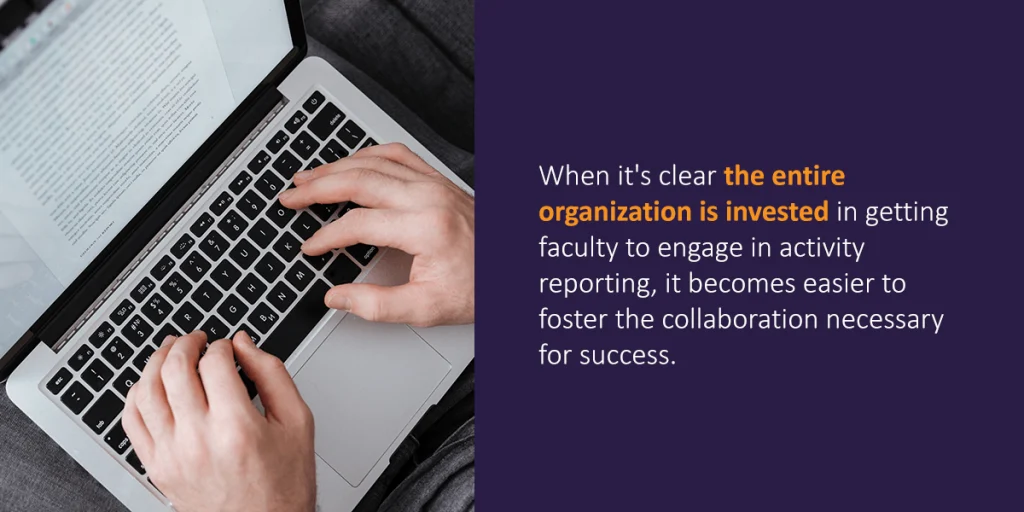




When Walden University implemented Watermark Faculty Success, it had two goals in mind — to improve faculty profiles on the university website and to streamline regional and programmatic accreditation reporting. Like many universities implementing a faculty activity reporting solution, Walden faced the challenge of engaging its remote faculty to use the system.
Walden started with Faculty Success — formerly known as Digital Measures — in March 2017 and rolled it out to faculty in January 2018. During this period, Walden set a new standard for ensuring faculty investment in using the system.
While the university specifically used these practices with its remote faculty, traditional institutions can also use them as a roadmap to success. Here are Walden’s seven best practices for engaging faculty.
Walden’s initial implementation group included university members who had the technical expertise to structure and support new software, such as IT representatives and others who were familiar with pulling data from campus data sources. While the technical team did the necessary groundwork for initial setup, Walden formed an advisory council made up of faculty and program leadership from each of the schools and staff from various departments, including the library and Center for Faculty Excellence.
“With feedback from faculty across the university, the advisory council finalized a name for the system and branded it as the Faculty Insight Tool (FIT),” said Alexandra Aragno, associate director of operational excellence at Walden’s Center for Faculty Excellence. “The council also had a great recommendation to increase faculty ownership by allowing them to choose what profile information would be displayed on Walden University’s website.”
“The key to a successful launch is running pilot tests to work out any kinks,” said Jim Lenio, executive director of Walden’s Office of Institutional Research and Assessment. “After conducting two pilot tests, the first with new incoming faculty and the second with existing faculty, we discovered differences in needs and could then tailor specific resources and guidance. The pilots also built a group of faculty advocates who were supportive and excited about the new system.”
During the first pilot with new faculty, the Walden team learned the group’s challenges and concerns and made adjustments before testing the platform with current faculty.
“It was a big win,” said Aragno. “We surveyed the pilot groups and used those results to develop guidelines that became best practices. We also tweaked the system to provide additional guidance in individual screens, based on the most frequently asked questions and concerns.”
The pilot tests revealed that FIT was intuitive, which meant getting buy-in would be the biggest hurdle in engaging faculty.
The Walden University team communicated with faculty early and often by using various channels and methods, including newsletters, emails, presentations, and videos.
Rather than waiting until implementation to begin promoting the new program, the team aimed to provide as much notice as possible by publishing teasers in the monthly faculty newsletter. The team also requested that faculty members who had used the software at other universities step forward.
“One of our respondents had been a Faculty Success administrator at a different university,” said Lenio. “She provided us with valuable insight, including a list of questions and things she wanted us to consider. It helped us see what had been done elsewhere.”
In addition to using various communications methods, Walden found it important for faculty to hear about the new program from different audiences. The first official communication about FIT went out by email from Walden University Interim President Dr. Ward Ulmer and Chief Academic Officer and Provost Dr. Eric Riedel. The team is now working closely with deans and directors to continue promoting the use of the system by all faculty.
“It’s important for university leadership to lead the way in initial communication to help set expectations and encourage engagement,” said Lenio. When it’s clear the entire organization is invested in getting faculty to engage in activity reporting, it becomes easier to foster the collaboration necessary for success.

The Walden team worked to socialize the new system throughout implementation so faculty were invested by the time it rolled out. Because Walden has a globally dispersed faculty, the team had to develop and implement various engagement methods to get the buy-in they needed.
They started the engagement process by allowing faculty to submit and vote on internal names for Faculty Success, giving them a greater sense of ownership and investment in the platform.
“When we sent out the survey, we shared a 30-second video that showed faculty what the system looked like at that time,” said Lenio. “It walked through screens and had a voice-over so it wasn’t this mysterious thing that’s coming that no one’s ever seen. We wanted to give them an inside look before picking a name. In the end, faculty voted for the name Faculty Insight Tool, or FIT.”
After selecting the name, the advisory council worked with the marketing department’s creative team to design a FIT logo to brand the system. The team believed the logo would foster additional buy-in from faculty while giving it a strong visual representation in communications.
Another way the team socialized the system was by introducing it at Walden University’s National Faculty Meeting, a time when faculty and academic leadership come face-to-face for professional development opportunities.
“We created a one-page handout summarizing the FIT that was given to each faculty member at registration,” said Aragno. “We also set up a table where advisory council members could share information and hand out giveaways to promote the FIT ahead of rolling it out to faculty.”
After the National Faculty Meeting, Walden provided various tools and training methods such as webinars and presentations geared to different groups. As more questions arose, the team created two-to-five-minute videos to help clear up confusion and facilitate easy interaction with the FIT.
Although faculty have been successfully using this system for several years, Walden continues looking for ways to socialize the FIT.
“We’re looking at rewarding faculty through small gifts that can be obtained through an online store,” said Lenio. “Faculty who entered the minimum information requested into the FIT would receive a code they can use to get one of the thank-you items, such as a laptop sleeve or mug with Walden branding.”
Aragno emphasized the importance of making things as easy as possible for faculty when customizing the FIT. For example, an internal knowledge base keeps faculty from losing momentum by allowing them to stay within the system when looking for help. Users often skip reading the instructions and help guides when learning new software because they have trouble finding the information they need.
“Many faculty are savvy and can go in without direction because they intuitively understand how to navigate the screens,” Aragno said. “But we provide materials for faculty who may struggle so they can go in and figure it out quickly and more easily.”
Walden also wanted to make the FIT beneficial by enabling faculty to customize their profiles on WaldenU.edu. Hundreds of Walden faculty members have decades of experience in teaching or academic work, which is hard to condense into an online profile. The FIT tool categorizes this information by degrees, awards, published works, and more. Faculty can choose the content they want to display online, whether that involves showcasing all their information or highlighting a select few items.
Faculty appreciate specific directions and clear expectations like they appreciate an effective syllabus.
Initially, the Walden team directed faculty to specific areas of the FIT to help populate the tool with the most useful information. To help narrow the scope, faculty were asked to input data from faculty activity reporting over the past five years, including:
The Walden team also focused on conveying an accurate estimate of the time commitment required and encouraged faculty to work with their supervisors to set reasonable deadlines for having things in the system.
Post-launch, the software team has shifted their focus to helping leadership understand:
What kind of access they have to the system.
What this access enables them to do.
How they can use the system for reporting.
For example, leadership can tailor report information for program-level meetings with faculty and include valuable data in various reports and communications materials.
“We give information they need in digestible chunks and enable them to be more active in engaging faculty to use the system and fill in missing data,” said Lenio.
Implementing the FIT was an educational experience for Walden’s team, providing valuable lessons for future technology projects. Here are the three most important takeaways from Walden’s implementation experience:
Ultimately, going into the project with the assumption that you will face some degree of resistance is one of the best ways to prepare for success. Proactively plan how you will counter that resistance using the methods above, and you’re in a much better situation for a successful implementation.
Founded in 1970, Walden University is dedicated to making education more accessible for working professionals. The university currently serves students from across the United States and the globe with a diverse array of more than 100 online bachelor’s, master’s, and doctoral degree programs.
Walden University is accredited by The Higher Learning Commission, verifying that its course offerings meet the rigorous educational standards of a quality institution of higher learning.
Walden is also part of the Laureate International Universities network, indicating its dedication to providing excellent education to students around the world. Visit the university’s website for more information about Walden.

If you’re looking for a better way to increase faculty engagement with activity reporting, Watermark Faculty Success can help your institution drive innovation among faculty and administration.
Faculty Success pulls faculty data from various sources, including publication databases, CV imports, and HR software, creating a centralized data hub for easy access and quick reporting.
With capabilities like on-demand reporting and tailored data configuration, administration and faculty can quickly find the answers and insights they need when they need them.
Faculty Success also seamlessly integrates with the full Watermark suite, creating a single source of truth for all your institutional data. Simplify processes like annual faculty reviews, course evaluations, and more with our comprehensive solutions. Contact us today to request a free Faculty Success demo.
























































































































































































































































































































































































Submit this form to schedule a meeting with one of our reps to learn more about our solutions. If you need customer support instead, click here.